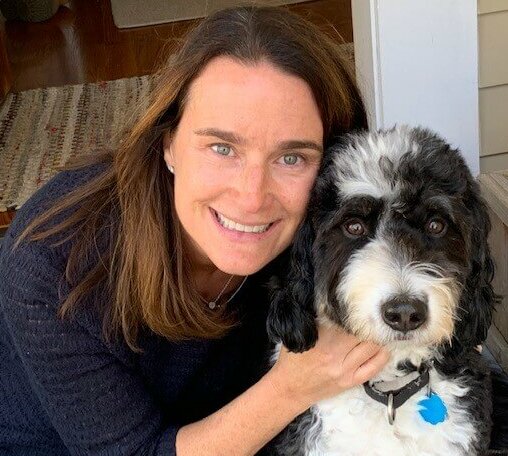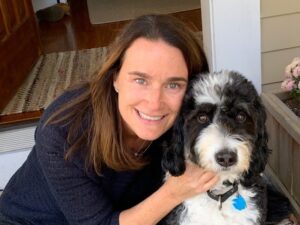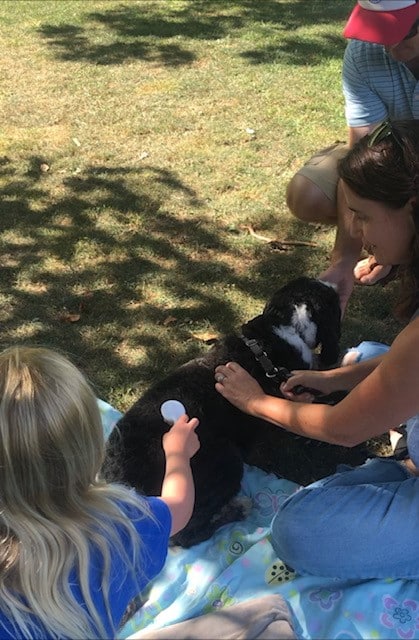



One of the roles Pet Partners teams can play is working in partnership with professionals so these professionals can incorporate animal-assisted interventions (AAI) into their practice. Working with a volunteer team gives practitioners access to a reliable, credentialed therapy animal and a handler who can advocate for the animal and ensure interactions are safe, while the practitioner guides the therapeutic activity. This can be a significant benefit for professionals not in a position to have their own therapy animal, or who want the benefits of having a handler available to support the safety of the intervention. Recently, Stefani M Cohen, LCSW, partnered with Pet Partners team Lauren Wilson & Nico for a unique animal-assisted therapy opportunity.
I am a licensed clinical social worker and work with parents and young children in my regular practice. I have developed a niche of using exposure therapy with real dogs to help people of all ages overcome a fear of dogs, aka cynophobia.
Since we’re afraid of things we don’t understand, I always do my best to educate children about dogs so they feel more in control and safer. I call these dog lessons. As I tell parents, we teach kids safety procedures like how to cross the street and not to touch the stove, but most parents don’t teach kids how to stay safe around dogs and how best to interact with them.
This session was my first in-person meeting with Tricia (name changed), who is 7-1/2. We had done a virtual session where I established trust and we went over some pictures of how dogs communicate. I use the virtual session to get more information about the child’s specific fear and their previous interactions with dogs. In Tricia’s case, she said she was mostly afraid of being jumped on, although this had not happened to her. Her grandmother has a small older dog who Tricia feels comfortable with although she has not pet him.
I do not currently have a therapy dog partner. (I am on my third keeshond and we are taking therapy dog classes. I had two previous keeshonden who were registered with Delta Society/Pet Partners, so I have a good idea of what is involved.) I reached out to the local Pet Partners group to locate a team who could work with me for this intervention. I knew it would be very important to be assisted by a team where the dog was calm and able to remain quiet for a good amount of time. I thought Nico and Lauren would be a good fit.

We met at a park and Tricia was accompanied by her mother and father. For the first 20 minutes, Tricia stood about 12 feet away from the therapy dog team. Nico laid comfortably on a blanket and was supported by Lauren. Both Nico and Lauren were patient and we all let the process evolve.
Periodically I asked Tricia to number her fear using a 1-10 model. 10 is the most afraid. She hovered around 7; we did some deep breathing and I encouraged her to look at Nico as we talked about him. At times she cried because she felt so scared.
Gradually she was able to move closer to Nico and eventually, with her parents’ support and encouragement, she was able to hold her father’s arm as he pet Nico. She worked her way up to touching Nico with one finger and then her whole hand! She even had the opportunity to brush Nico.

Nico remained calm and quiet throughout these activities, although occasionally he readjusted his position. Whenever Nico moved Tricia jumped back and her fear elevated again. If Lauren was able to predict his movements ahead of time, she would prepare Tricia for that, and then Tricia felt more in control and less scared.
To give Nico a break while also continuing with the exposures, we had Lauren walk Nico near us and Tricia practiced turning sideways if she felt scared as they walked by. The session ended with Tricia feeling proud and excited for her reward of ice cream for trying her hardest.
I use a certificate with several activities to check off at the end of a session. Tricia was able to check off 1) Being near a dog 2) Petting a dog and 3) Brushing a dog. She said her fear level had come down to about 4 or 5 by the end of the session!
It was a great session and Nico and Lauren were fantastic assistants.
Postscript, about two weeks later: Update on Tricia’s progress—we met recently and she was petting and brushing Nico within 10 minutes.